Trees With Spiky Seed Balls (With Pictures) – Identification Guide
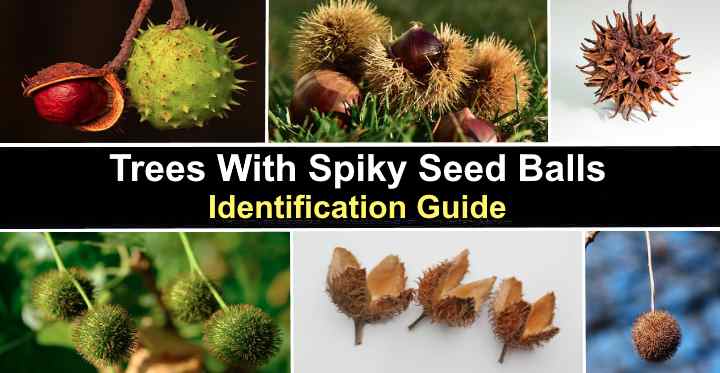
Trees with spiky seed balls are generally easy to identify. In late summer and fall, trees like buckeye, chestnut, and sweet gums produce spherical round seed balls covered with prickly spikes. In some cases, the spiked seed balls don’t do any harm. However, round seed pods with sharp spikes can be painful if you step on them barefoot.
Compared to typical seed-bearing trees, spiky seed balls are relatively uncommon. In fact, only five or so tree genera produce seeds covered in spiky husks. The spherical prickly pods can be green with short, stiff spines, relatively smooth, soft prickles, or brown with curled sharp spikes.
Have you ever encountered a tree with spiky seed balls hanging from its branches? These unique trees are fascinating, but have you ever wondered what they are called and what purpose they serve?
This article describes some of the most popular types of trees with spiky seed balls, their characteristics, and their uses. You will discover more about these distinctive tree fruits wrapped in a prickly husk, from the American sweetgum tree to the common buckeye and sweet chestnut.
What Are Trees With Spiky Seed Pods?
The most common trees with spiky seed pods are the chestnut tree (Castanea), buckeye (Aesculus glabra), or sweet gum (Liquidambar styraciflua). These tree species are the most common in North America. Other trees with spiky round seed balls are sycamore, beech, or London plane trees.
Trees With Spiky Seed Balls (Pictures and Names) — Identification Guide
Trees with spiky seed balls are fairly uncommon compared to other tree species. The distinct seed pods with spiky or prickly exteriors can look unusual dangling from trees. Or you may see them on the ground in the fall.
Here are pictures and descriptions of some of the most common trees with spiked seed pods.
Buckeye Tree (Aesculus glabra)
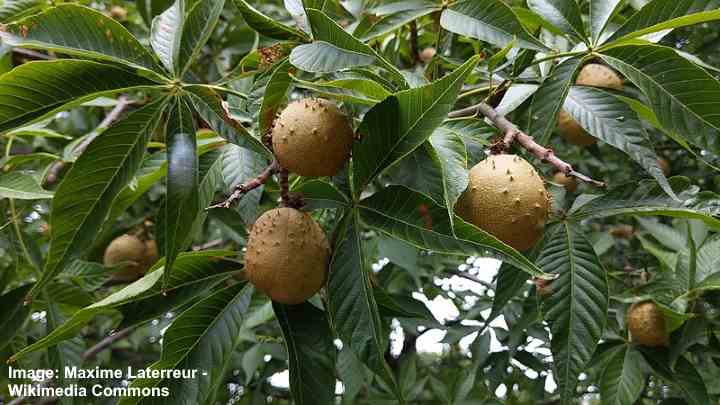
Buckeye tree round spiky seed balls are green when immature and turn to brownish-tan
Buckeye trees are among the most common flowering tree species that produce green spiky seed balls. The round prickly seed capsules measure 1.5” to 2” (4 – 5 cm) in diameter and contain one to three nut-like seeds. The round seed balls start green before turning leathery tan before they split.
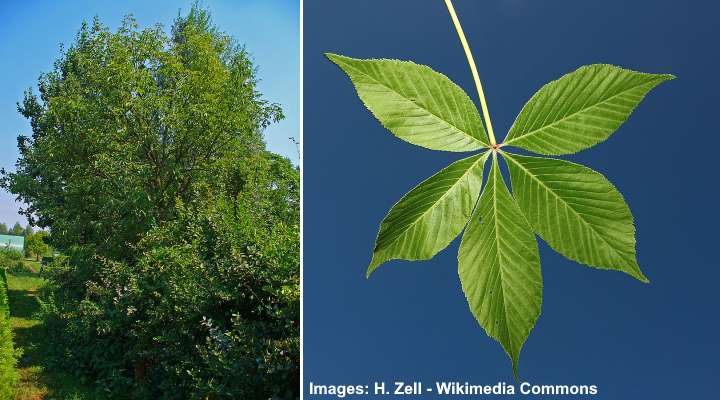
Buckeye tree leaves (right)
The seeds of buckeye trees are shiny and dark brown. An easily identifiable feature of them is the pale tan or whitish scar, giving the nut the appearance of a deer’s eye—hence the name buckeye tree. The buckeye seeds measure 1” to 1.5” (2.5 – 4 cm) across.
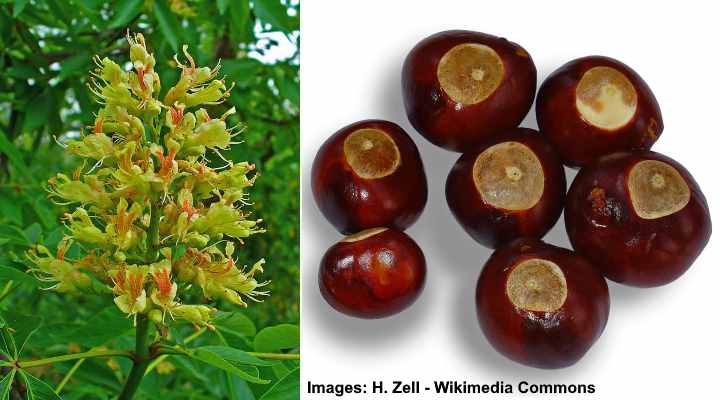
Buckeye tree flowers (left) and seeds (right)
Buckeye trees are native to the United States and are known for their impressive structure, large crown, and fissured bark. The ornamental trees are identified by their conical clusters of yellowish-green or red flowers, large palmate leaves, and clusters of spiky seed balls.
Buckeye trees grow 20 to 40 ft. (6 – 12 m) tall and wide and thrive in USDA zones 3 to 7. Common names for Aesculus glabara include Ohio buckeye, Texas buckeye, and Fetid buckeye.
Horse Chestnut Tree (Aesculus hippocastanum)
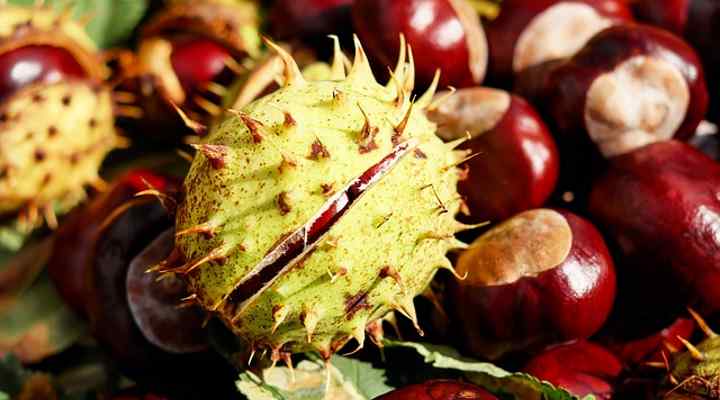
Horse chestnut seed balls look like a spiky green balls dangling from the ends of the tree branches and contain inedible nuts
Horse chestnut trees are popular landscaping trees in Europe, known for their green seed balls covered in sharp spines enclosing a shiny brown nut. Each spiked seed pod measures 2” (5 cm) in diameter, and the brown nut-like seed is 0.75” to 1.5” (2 – 4 cm) in diameter.
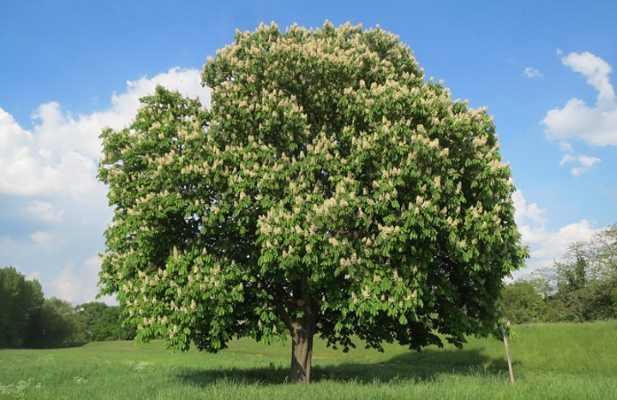
Horse chestnut tree
Between one and five of these prickly seed balls grow on woody stems. The green seed capsules develop through summer and fall before dropping in late September.
Apart from spiny seed pods, other identifying features of horse chestnut trees are their conical clusters of pinkish-white flowers and large palmately compound leaves.
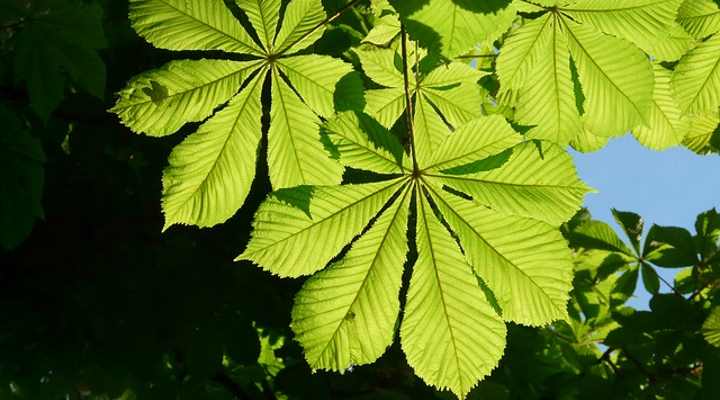
Horse chestnut leaves
Horse chestnut seed balls are visually appealing and provide food for wildlife, making them beneficial for the environment.
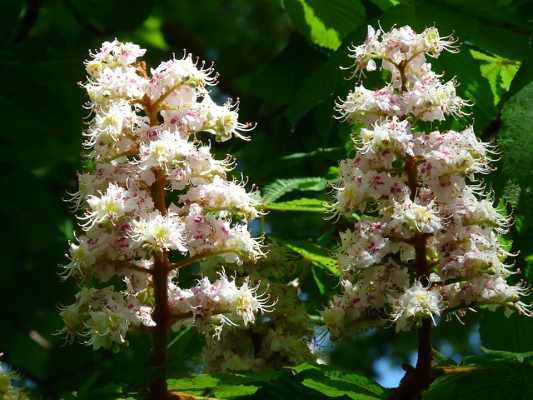
Horse chestnut flower
Horse chestnut trees grow up to 128 ft. (40 m) when fully mature. The deciduous trees thrive in USDA zones 3 through 8, where their large, spreading crown makes them excellent shade trees. They also have an attractive fall color when the foliage turns reddish-brown.
American Chestnut Tree (Castanea dentata)
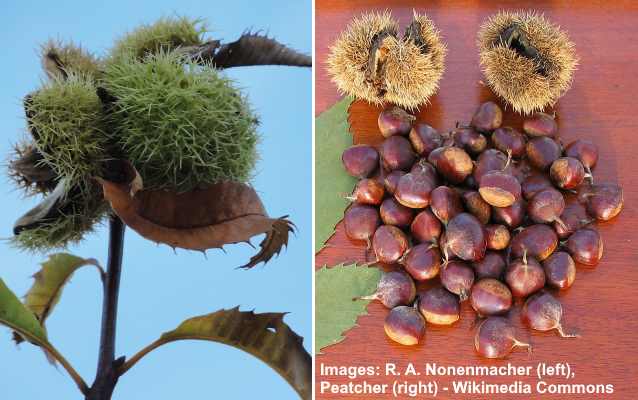
American chestnut spiky seed balls mature from green to brown and contain edible nuts
The American chestnut tree is a large, fast-growing deciduous tree that produces ball-shaped burred seed pods. The spiky seed balls contain several edible nuts. Growing in small clusters, the prickly burrs measure 2” to 2.5” (5 – 6 cm) wide. The edible nuts are ready for consumption in September and October.
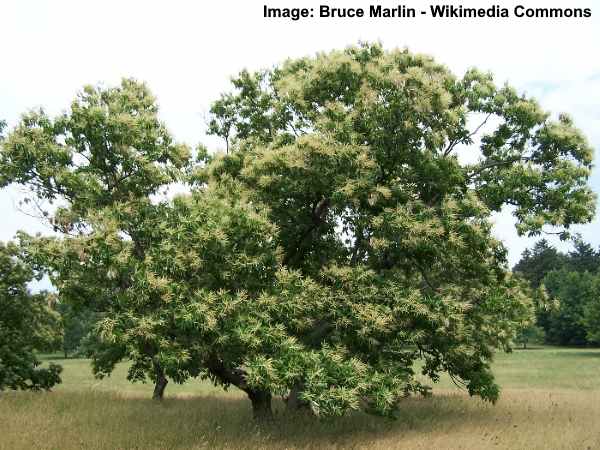
American chestnut tree
American chestnut trees grow 50 to 70 ft. (15 – 21 m) tall, with some specimens reaching 100 ft. (30 m).
Identifying features of the native American chestnut trees are long finger-like clusters of yellowish flowers growing 8” (20 cm) long, elongated toothed, lanceolate leaves and spiky tan-colored seed balls.
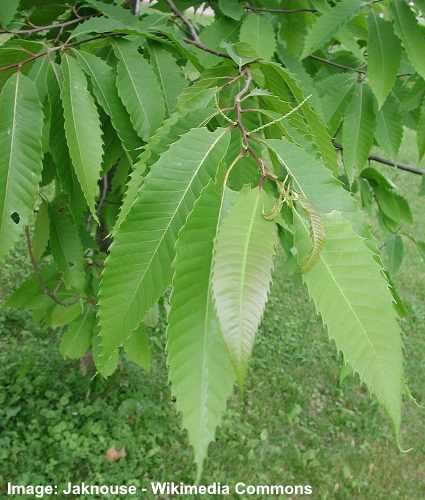
American chestnut leaves
American chestnut trees are hardy in USDA zones 5 through 8. The large landscape trees are ideal for shade or producing abundant crops of edible nuts for roasting.
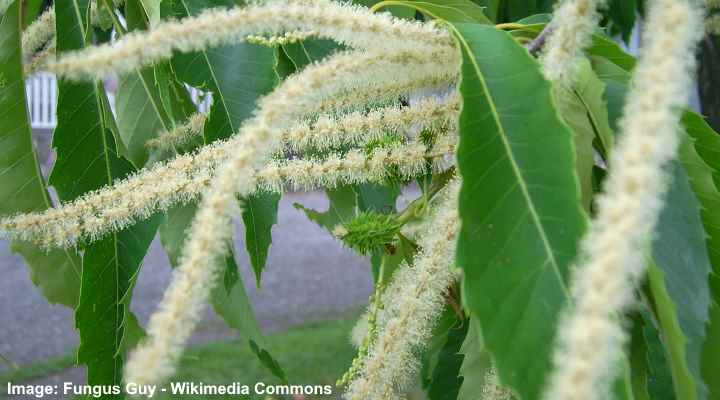
American chestnut flowers
Apart from the American chestnut tree, other native trees with seed pods with sharp spines are the Allegheny chinquapin (Castanea pumila) and Ozark chinkapin (Castanea ozarkensis).
Sweet Chestnut (Castanea sativa)

Sweet chestnut spiky seed balls contain large brown edible nuts
Sweet chestnut trees are a common deciduous tree species that produces brown nuts enclosed in prickly husks. The spiky seed balls (cupules) grow in clusters of two to six balls and contain three to seven reddish-brown nuts measuring 2” (5 cm) in diameter.

Sweet chestnut tree
Native to Europe, the sweet chestnut tree also grows throughout the United States.
The identifying features of the chestnut trees are their large glossy green lance-shaped leaves, cylindrical clusters of yellowish flowers, and burr-covered seed pods containing edible brown nuts.
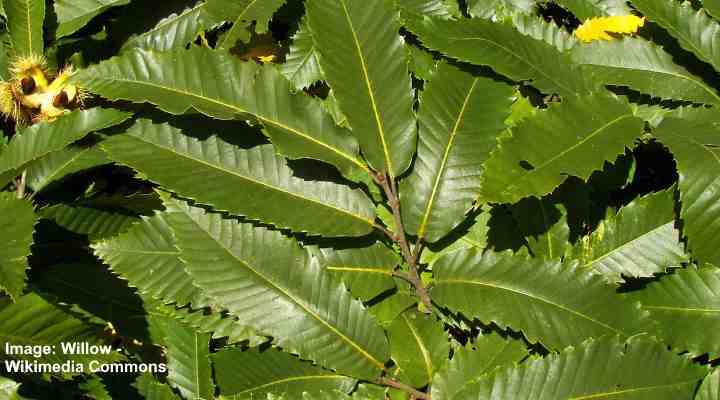
Sweet chestnut leaves
Sweet chestnut trees thrive in USDA zones 5 to 7 in full sun. The majestic trees with their green spiky tree seeds grow 80 to 100 ft. (24 – 30 m) tall and up to 50 ft. (15 m) wide.
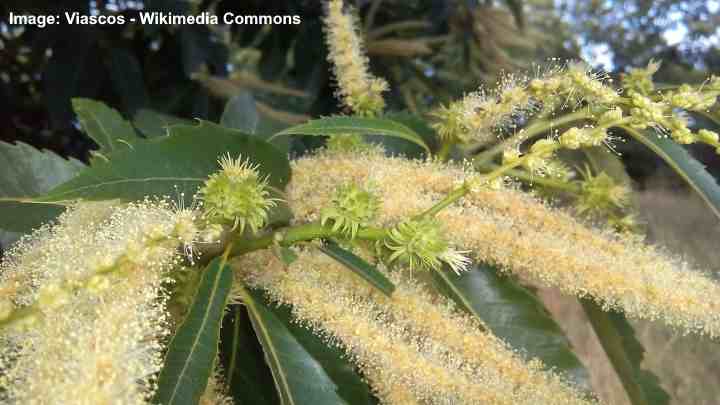
Sweet chestnut flowers
It’s vital not to confuse the triangular brown tree seeds of the sweet chestnut tree (Castanea sativa) with those of the buckeye or horse chestnut trees (Aesculus spp.).
Although they are called chestnut trees, only nuts from trees in the genus Castanea are edible.
American Sweet Gum (Liquidambar styraciflua)
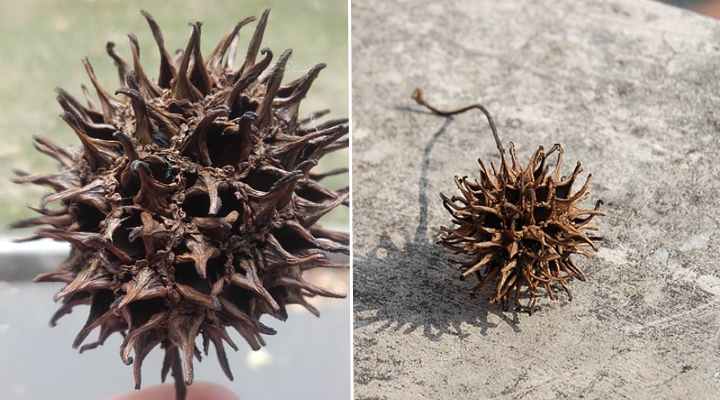
American sweetgum rounded brown seed balls are hard spiky capsules
The American sweet gum would be a popular landscape tree if it weren’t for the sharp, spiny tree pods that fall to the ground. The spike-covered capsules measure 1” to 1.5” (2.5 – 4 cm) and drop from trees in the fall and winter. The spiky brown seed pods have stiff, triangular spikes covering the seeds.
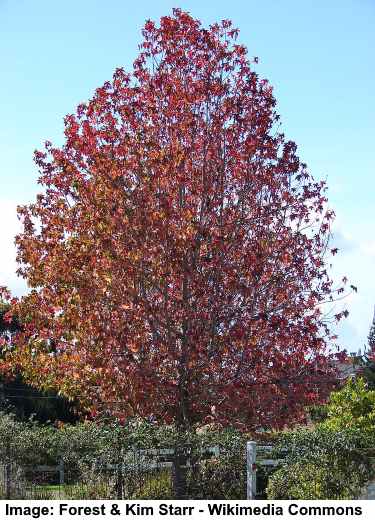
American sweetgum tree
Sweet gum trees are identified by their striking star-shaped leaves, small yellowish-green flowers, and light gray bark with irregular ridges. Additionally, the attractive tree has a broad, pyramidal spreading canopy that provides shade in landscapes. In the fall, sweet gum tree foliage turns eye-catching shades of orange, red, gold, and burgundy.
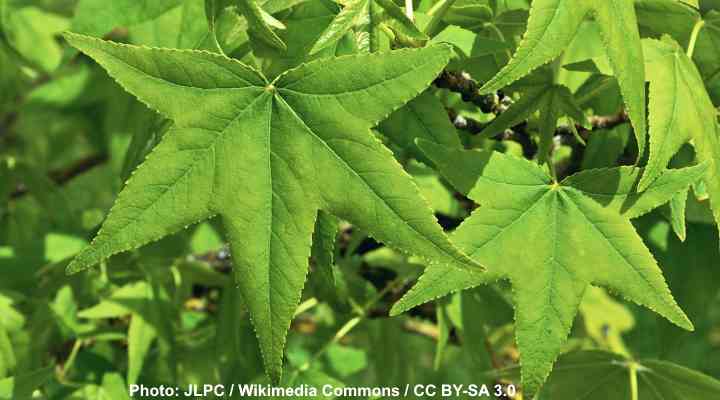
American sweetgum leaves
Sweet gum trees grow on average 60 to 80 ft. (18 – 24 m) tall and up to 40 ft. (12 m) wide.
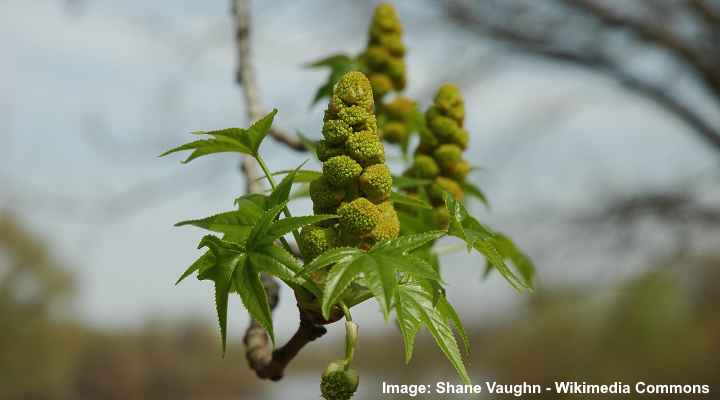
American sweetgum flowers
The sharp, rounded seed balls or gum balls from the tree can be potentially hazardous in yards. The stiffy, spiked balls can cause pain if you stand on them barefoot. Additionally, it’s easy to slip on them and fall. Therefore, many homeowners look for alternatives to sweet gum trees for garden landscapes.
American Sycamore Tree (Platanus occidentalis)
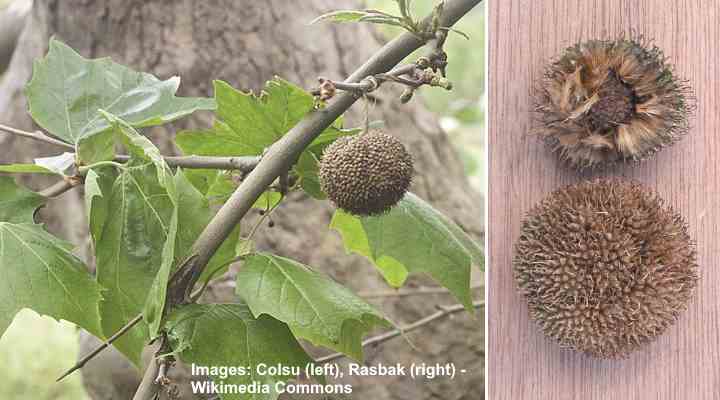
American sycamore tree round seed pods
The American sycamore tree is an eye-catching deciduous tree with mottled flaking bark and round brown seed pods covered in fuzzy spikes.
The ball-like seed pods of the sycamore tree measure 1” (2.5 cm) in diameter and dangle conspicuously on long petioles during fall and winter. Inside the fuzzy seed balls are many seeds that look like white tufts.
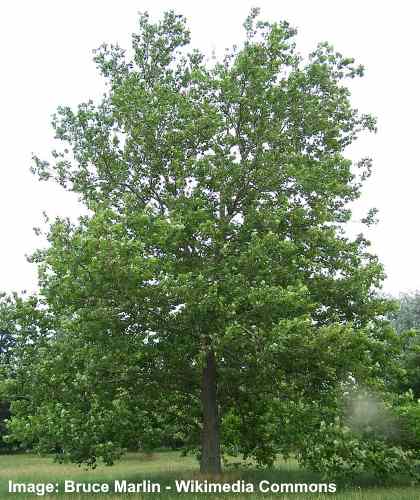
American sycamore tree
Sycamore trees are large and majestic trees known for their large, wide trunks, crooked branches, maple-like lobed leaves, and round spiky seed-filled brown balls.
Additionally, the exfoliating gray bark of the fast-growing tree flakes off in patches revealing white inner bark. The trees grow 70 to 100 ft. (21 – 30 m) tall and wide.
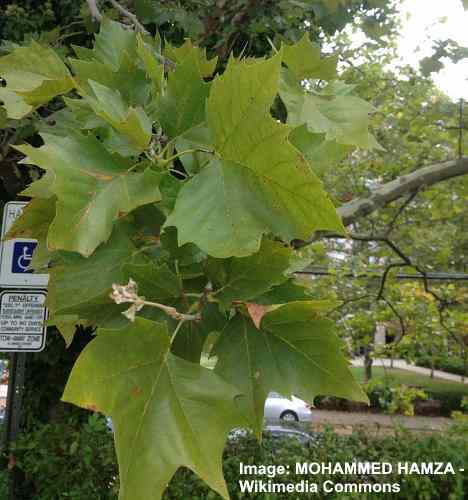
American sycamore leaves
When the round spiky tree balls are ripe, their fibrous husks break down, releasing hundreds of fluffy seeds on the wind. Or, the seed balls drop to the ground, where they split open to release their seeds.
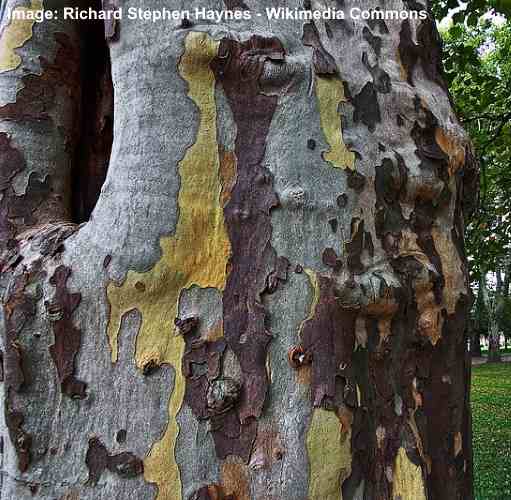
American sycamore bark
Sycamore trees are excellent shade trees for large, open landscapes. Thriving in USDA zones 4 through 9, the majestic trees grow throughout much of the United States.
London Plane Tree (Platanus x acerifolia)
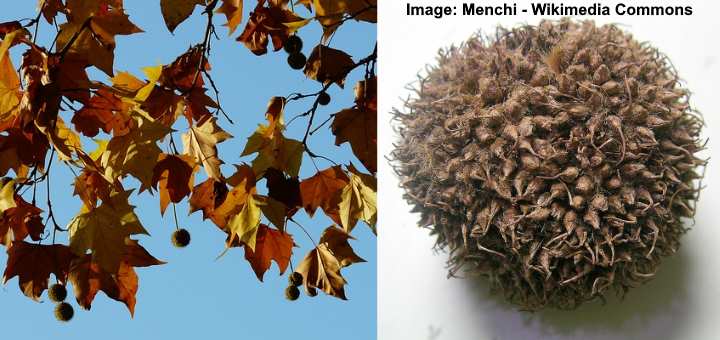
London plane tree round spiky seed balls
The London plane tree is a large deciduous tree known for its spiky brown seed balls.
Like the sycamore tree, these round fuzzy seed pods dangle on long petioles from branches in the fall and may persist through winter. The small seed-filled pods measure 0.80” – 0.12” (2 – 3 cm) in diameter.

London plane tree
This London plane tree is a beautiful and versatile hybrid of the American sycamore (Platanus occidentalis) and the Oriental plane tree (Planatus orientalis).
The London plane tree is a shade tree that grows 66 to 100 ft. (20 – 30 m) and has a trunk 10 ft. (3 m) wide. Additionally, it has a rounded, spreading canopy with a dense network of stunted branches.
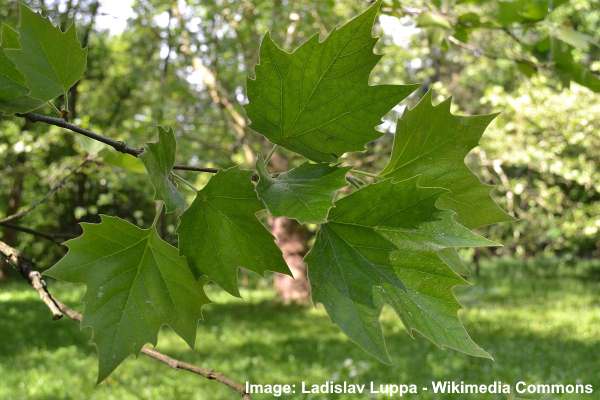
London plane tree leaves
Apart from its spiky seed balls that look like brown lollipops hanging on branches, there are several other identifying features of the London plane tree. It has palmately lobed leaves with three to five lobes, like a typical maple leaf, dense spherical clusters of small flowers, and smooth gray-green bark that sometimes peels.
American Beech (Fagus grandifolia)
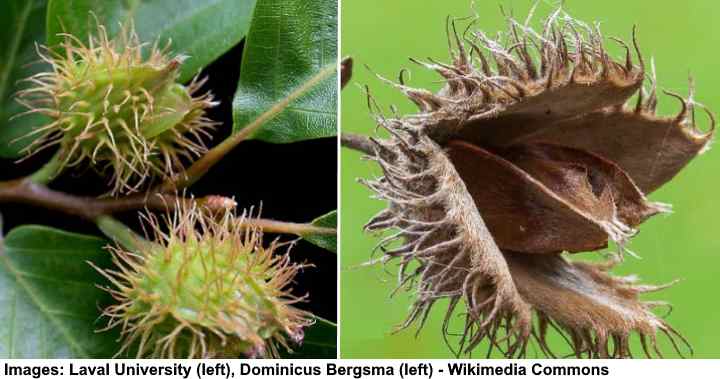
American beech immature and mature spiky seed pods
The American beech tree is a large deciduous tree with hard, light brown spiny seed pods. Rather than being round balls like other spiny pods on this list, the burr-covered capsules have three sides and an angular shape. The brown spiky seed pods measure 0.5 to 1” (1.12 – 2.5 cm) long.
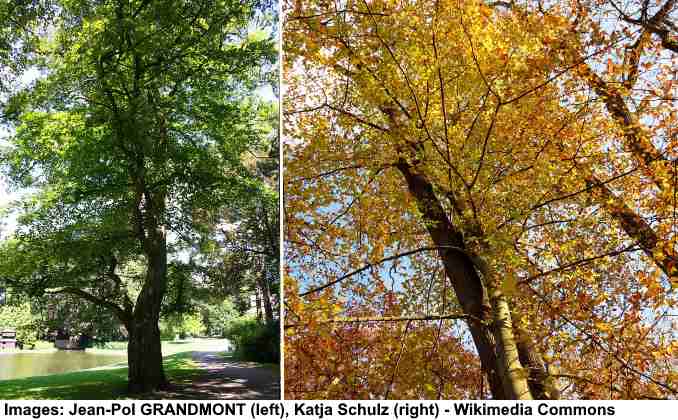
American beech trees
American beech trees grow 52 to 115 ft. (16 – 35 m) tall and have recognizable smooth, silver-gray bark.
Other identifying features of beech trees are their pointed, lance-shaped leaves with serrated margins, small yellow-green flowers, and bristly brown seed pods. In the fall, the tree’s foliage turns warm russet and golden yellow shades.

American beech leaves
American beech trees are native to the eastern United States. The deciduous broadleaf trees thrive in USDA zones 3 to 9. The imposing trees are ideal as shade trees in large landscapes. As a bonus, beechnuts from the spiky pods are edible.
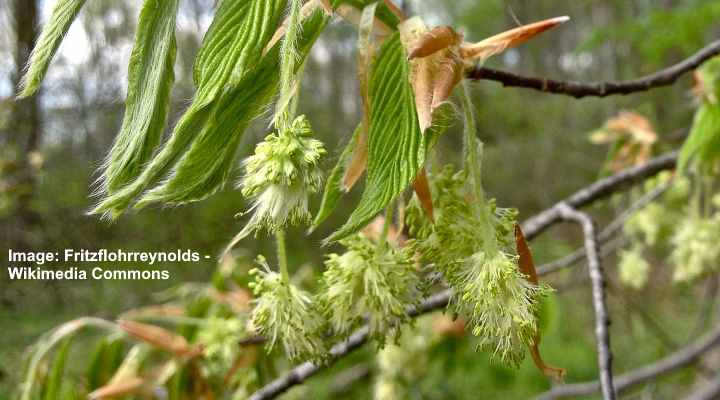
American beech flowers
How to get rid of spiky balls from trees
If you find that pesky spiky balls from trees are taking over your yard, don’t worry – there are a few simple ways to get rid of them. First, rake up any fallen seed pods around the tree’s base. This will prevent anyone from standing on them and also prevent saplings from growing in the spring.
However, if you want to stop chestnut, sycamore, or sweet gum trees from producing spiky seed balls, you must hire an arborist. They can inject hormones into the base of the tree to stop them from fruiting—think of it as a birth-control method for seed-producing trees. However, this process must be repeated annually.
Can you Plant Spiky Balls from Trees?
Collecting the seeds from spiky pods to grow trees from seed is possible. First, however, you must remove the nuts or seeds from the spiny husks. Additionally, some tree seeds need stratification to sprout. This is a process to expose seeds to cold, damp conditions like winter so they will germinate in the spring.
Seed-producing trees with fuzzy round balls, like sycamore and plane trees, contain tiny seeds that float on the wind. Therefore, collecting those seeds for replanting in the ground is usually too complicated.
However, you cannot plant spiky balls directly in the ground to reproduce new trees without first removing the nuts.
Do Animals Eat Spiky Balls That Drop from Trees?
Seeds and nuts from deciduous and evergreen trees are important food sources for wildlife. In most cases, the seed pods break apart to release the seeds. This happens with chestnuts and buckeye seed husks. For example, chipmunks, wild turkeys, squirrels, and deer feed on chestnuts from the American or sweet chestnut trees.
Similarly, spiky sweet gum balls contain seeds that attract a wide variety of birds, as well as squirrels and chipmunks.
Alternative to Sweetgum Trees and Other Trees that Produce Spiky Balls
If sweet gum tree balls are a nuisance in your yard, you could consider replacing the tree with a non-fruiting variety. For example, you could plant a roundleaf sweet gum tree (Liquidambar styraciflua ‘Rotundiloba’). This ornamental shade tree has attractive rounded leaves and beautiful crimson or purple fall colors. Ideal for medium-sized yards, the tree only grows 50 ft. (15 m) tall and 30 ft. (10 m) wide. But more importantly, it doesn’t produce the pain-causing spiky brown seed balls of typical sweet gum trees.
Related articles:
